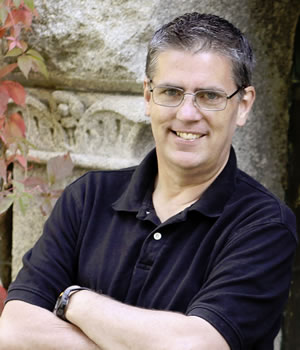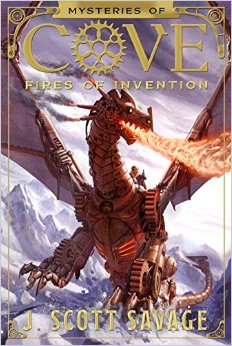 J. Scott Savage is is the author of 16 novels including the Mysteries of Cove series, the Farworld middle-grade fantasy series, and the Case File 13 middle-grade monster series. The following is a complete transcript of his interview with Cracking the Cover for his book “Fires of Invention.”
J. Scott Savage is is the author of 16 novels including the Mysteries of Cove series, the Farworld middle-grade fantasy series, and the Case File 13 middle-grade monster series. The following is a complete transcript of his interview with Cracking the Cover for his book “Fires of Invention.”
Why do you write?
This is one of those questions that I don’t think really has only one answer. It’s kind of like asking why you eat. Of course, it’s because you have to or you’d die. But most of the time you aren’t eating simply to keep from dying, right? I wouldn’t die if I stopped writing, (although my family might wish it a little; I get cranky when I stop writing for any length of time.) At the most base level, I write because it makes me happy. It’s like a spigot I can open up to release all the creativity that has been building up inside my brain. But I also write because there’s a specific story I need to tell. I write to share something I love with my readers. Way lower down the list, I write to get published. But even if I could never publish another book, I would still keep writing.
Why specifically do you write for young people?
I started writing for adults—mysteries, thrillers—and I still enjoy doing that. But writing for young people, and people who are young at heart, is a completely different experience. Middle grade novels have this element of magic to them, even when you’re writing a story with no fantasy elements at all. I think, at least in part, it’s because between the ages of 8-13, everything around you is magic. You are always discovering new things, new ideas, new places. I mean, take something like the San Diego Zoo, or Disneyland, or Yosemite. Those places are all cool, even when you’re an adult. But when you’re a kid it’s like discovering a new continent or something. It’s such an exciting time to be alive, that when you write about that age, everything has a magical quality to it.
 Where did your idea for “Fires of Invention” come from?
Where did your idea for “Fires of Invention” come from?
Most of my book ideas come from two separate ideas meeting each other, combining, and having little baby ideas. (Sorry, for going a little PG-13 on you there.) The first spark came when my wife and I went to see the Broadway musical Wicked. As soon as I walked into the theater and say the big mechanical dragon above the stage, my head started spinning. All I could think was, “I need to write about kids building a mechanical dragon. I need to write about kids building a mechanical dragon.”
The second piece if inspiration came from my nephew. He is one of the smartest and most creative kids I know. But his creativity often gets him into trouble. The two pieces merged and I thought, what if those kids were building a steampunk dragon in a city where creativity was against the law? Things just kind of took off from there.
Did you always know it was going to be a series?
I wanted it to be. I saw it as a trilogy and had a good idea of where it would go. But when you’re writing a book, you often don’t know if you’ll get a multi-book contract. So you have to write it as what’s called a standalone with series potential. One thing I knew was that even if it was made into a series, I didn’t want the first book to end with one of those big cliffhangers where you throw the book against the wall and curse the author. I felt pretty confident people would finish the first book and want to see where things go, but I wasn’t going to end mid-story.
Sum up “Fires of Invention” in two sentences.
In a world where creativity is against the law, a girl and a boy build something both amazing and very dangerous. What they discover as they do will change their world forever.
A lot of steampunk is imagination, but it also requires some engineering (when it comes to actual mechanics). How much research was involved?
A lot more than I thought. I had to research everything from the history of steam-powered engines to hydroponics. There are some things you have to take with a little bit of imagination, like a 30 foot tall metal dragon getting off the ground in the first place. But I wanted the technology to be as real as possible. I didn’t want anything that felt like I was forcing the reader to accept something that might pull them out of the story. Time will tell if I put in too much technology, but I’d rather err on that side, than going, “Yeah, it’s um, magic, I guess.”
Why dragons?
Oh man, dragons are just the coolest. I have always love dragons the most of any fantasy creatures. I love that they’re powerful, smart, and crafty, but that you have as many stories where they are good as where they are bad. And honestly, I think every fantasy reader imagines at some point how cool it would be to ride on the back of a dragon. So, if you don’t have the real thing, why not build one?
How much did the story change from original idea to final draft?
The main storyline stayed pretty true. The biggest changes came on the why side of things. One of my biggest complaints with books I read is that you see a world that is in a certain situation, but there’s no real explanation for why things are the way they are. Or people did something in the past, but the justification for why they’d do that is weak. My publisher did a great job of making me go back and put all of the whys in place. So as the kids discover what’s really going on in their city, the reader learns along with them not only what is happening, but why it happened that way. Also, once I knew for sure that there would be more books, I was able to add things I’d use down the road.
How did/does writing this book/series differ from your previous publications?
In some ways a lot. Steampunk was a new genre for me which made world building on this and other books both exciting and challenging. Also, there is no traditional magic. It’s like technology is there in place of spells and potions. In other ways not so much. I still like to focus on strong characters. I like the dynamics between people who all think they are doing the right thing for the right reason, but who come to very different conclusions. To me, action is a lot more exciting if you have other types of conflict tied into it. Give me a battle that is both physical and mental.
What makes “Fire of Invention” stand out among its contemporaries?
A couple of things. One is the genre. Steampunk is not all that common in middle grade, and combining that with dragons is kind of like mixing peanut butter and chocolate. Second, one of the things I see a lot in middle grade fiction, and have written myself at times, is an impetuous boy character who takes all the risks, and an smart, cautious girl who waits to see what happens. That is definitely not the case here. Trenton and Kallista are both smart, and excellent mechanics. But Kallista is much more the leader when it comes to taking risks. She’s the one who says, “I’m climbing through the vents to the next level. You can come or stay.”
What are you working on now?
Book two, which is tentatively titled Smoke and Mirrors. It takes the steampunk to a whole new level and introduces some great new challenges. A very different setting from book one, and definitely some new risks.
Is there a book from your own childhood that still resonates with you today
There are so many. A Wrinkle in Time, Charlotte’s Web, The Outsiders, Where the Red fern Grows, Lord of the Rings. Some of my best friends as I was growing up lived only on the pages of books and inside my head. It’s such a thrill to hear from my readers that they feel the same way about the characters from my books. It’s like everything has come full circle.
